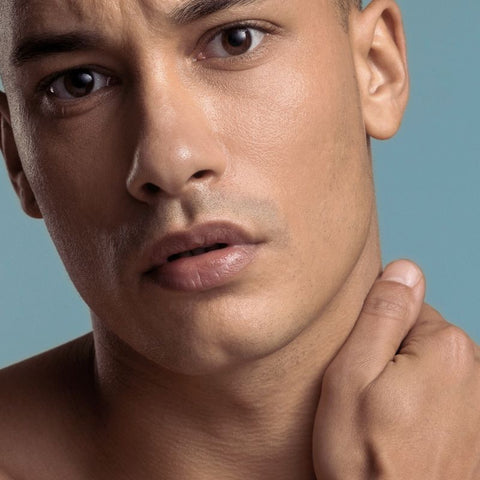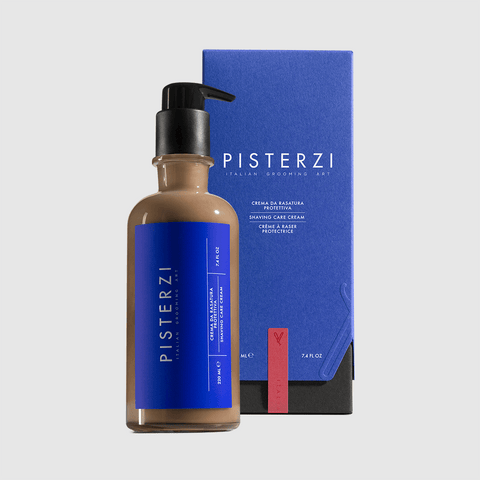
BEARD DANDRUFF - SYMPTOMS, TREATMENT, AND PREVENTION TIPS
BEARD DANDRUFF HAS BECOME A COMMON CONCERN FOR MANY MEN, PARTICULARLY AS FACIAL HAIR CARE GAINS PROMINENCE. WHILE SIMILAR TO SCALP DANDRUFF, BEARD DANDRUFF REQUIRES A TAILORED APPROACH FOR EFFECTIVE TREATMENT AND PREVENTION. THIS GUIDE WILL DELVE INTO THE SYMPTOMS, CAUSES, AND SOLUTIONS TO HELP YOU MAINTAIN A HEALTHY, WELL-GROOMED BEARD.
THE GOOD NEWS IS THAT BEARD DANDRUFF IS TYPICALLY EASY TO MANAGE WITH SIMPLE ADJUSTMENTS TO YOUR GROOMING ROUTINE. MOST MEN FIND THAT THESE CHANGES LEAD TO A HEALTHIER, MORE ATTRACTIVE, AND COMFORTABLE BEARD.
WHAT IS BEARD DANDRUFF?
BEARD DANDRUFF, MUCH LIKE ITS SCALP COUNTERPART, IS CAUSED BY AN OVERGROWTH OF MALASSEZIA, A YEAST-LIKE FUNGUS THAT THRIVES ON THE SKIN'S NATURAL OILS. THIS CAN LEAD TO IRRITATION, FLAKINESS, AND INFLAMMATION. COMMON SYMPTOMS INCLUDE:
- RED AND FLAKY SKIN BENEATH THE BEARD
- PERSISTENT ITCHING IN THE BEARD AREA
- WHITE FLAKES ON THE HAIR AND SKIN
- GREASY OR OILY SKIN THAT CONTRIBUTES TO FLAKING
ALTHOUGH BEARD HAIR DIFFERS FROM SCALP HAIR IN TEXTURE, THE SYMPTOMS AND TRIGGERS FOR DANDRUFF ARE SIMILAR. KEEPING THE SKIN BENEATH YOUR BEARD HEALTHY IS CRUCIAL FOR AVOIDING THESE ISSUES AND ENSURING YOUR BEARD LOOKS ITS BEST.

CAUSES OF BEARD DANDRUFF
LIKE REGULAR SCALP DANDRUFF, BEARD DANDRUFF CAN BE CAUSED BY SEVERAL FACTORS. WE’VE FOUND THESE FOUR TO BE THE MOST COMMON:
- DRY SKIN: WHEN THE SKIN BENEATH YOUR BEARD IS TOO DRY, IT CAN PEEL AND FLAKE, ESPECIALLY IN COLDER WEATHER OR DRY CLIMATES. USING A GENTLER BEARD WASH AND INCORPORATING CONDITIONING PRODUCTS LIKE BEARD OIL CAN HELP RESOLVE DANDRUFF CAUSED BY DRY SKIN.
- OVERLY OILY SKIN: THE MALASSEZIA FUNGUS THRIVES ON OILY SKIN, BREAKING DOWN NATURAL SEBUM AND PRODUCING OLEIC ACID, WHICH IRRITATES THE SKIN AND CAUSES FLAKES. EXFOLIATING AND WASHING YOUR BEARD MORE FREQUENTLY CAN HELP MANAGE THIS CONDITION FOR MEN WITH OILY SKIN.
- CONTACT DERMATITIS: THIS OCCURS WHEN YOUR SKIN HAS AN ALLERGIC REACTION TO INGREDIENTS IN SOAPS, COSMETICS, OR FRAGRANCES. ELIMINATING THE OFFENDING PRODUCTS CAN RESOLVE THIS ISSUE.
- SEBORRHEIC DERMATITIS: A CHRONIC FORM OF ECZEMA, SEBORRHEIC DERMATITIS CAUSES EXCESSIVE FLAKING AND ITCHING. MEDICATED CREAMS AND LOTIONS PRESCRIBED BY A DOCTOR CAN HELP MANAGE THIS CONDITION.

HOW TO TREAT BEARD DANDRUFF
BUILDING A PROPER BEARD CARE ROUTINE IS THE KEY TO ELIMINATING DANDRUFF. FOLLOW THESE FOUR STEPS TO TREAT AND PREVENT BEARD DANDRUFF WHILE KEEPING YOUR BEARD HEALTHY.
- CLEANSE THE BEARD PROPERLY: USING THE RIGHT PRODUCT TO WASH YOUR BEARD IS CRUCIAL. OPT FOR A GENTLE, BEARD-SPECIFIC CLEANSER TO REMOVE DIRT AND EXCESS OILS WITHOUT STRIPPING ESSENTIAL MOISTURE. MASSAGE YOUR BEARD USING GENTLE CIRCULAR MOTIONS, ENSURING THE CLEANSER REACHES THE SKIN BENEATH. THE LATHER WILL LOOSEN DIRT FROM THE HAIR SHAFTS AS YOU RINSE. PAT YOUR BEARD DRY WITH A SOFT TOWEL INSTEAD OF RUBBING IT TO PREVENT DAMAGE. AVOID OVER-WASHING, AS THIS CAN STRIP THE SKIN OF ESSENTIAL MOISTURE, LEADING TO MORE IRRITATION. FOR MEN WITH DRY SKIN, REDUCE THE FREQUENCY OF WASHING TO TWO OR THREE TIMES A WEEK, WHILE THOSE WITH OILY SKIN MAY BENEFIT FROM MORE FREQUENT WASHES.
- EXFOLIATE THE SKIN: DEAD SKIN CELLS CAN LEAD TO FLAKINESS. USE A BEARD-SAFE EXFOLIATING PRODUCT TO REMOVE DEAD SKIN TRAPPED BENEATH YOUR BEARD, PROMOTING HEALTHIER SKIN.
- MOISTURIZE REGULARLY: APPLY A BEARD MOISTURIZER AFTER CLEANSING TO KEEP YOUR SKIN AND BEARD HYDRATED. THIS STEP IS CRUCIAL TO REPLACE ANY SEBUM LOST DURING WASHING, ESPECIALLY AFTER A SHOWER.
- TRIM REGULARLY: KEEPING YOUR BEARD WELL-TRIMMED HELPS PREVENT INGROWN HAIRS, WHICH CAN IRRITATE THE SKIN AND WORSEN DANDRUFF. A WELL-GROOMED BEARD NOT ONLY LOOKS GOOD BUT ALSO FEELS COMFORTABLE.
BEST PRODUCTS FOR TREATING BEARD DANDRUFF
USING THE RIGHT PRODUCTS IS ESSENTIAL FOR TREATING AND PREVENTING BEARD DANDRUFF. HERE ARE THREE MUST-HAVE PRODUCTS FOR YOUR BEARD CARE ROUTINE:
SHAMPOO AND CONDITIONER FOR BEARD AND HAIR.
CHOOSE PRODUCTS WITH NATURAL INGREDIENTS THAT GENTLY CLEANSE WHILE NOURISHING THE SKIN AND BEARD. OUR SHAMPOO AND CONDITIONER CONTAINS 85% NATURAL INGREDIENTS AND IS NICKEL-FREE, MAKING IT IDEAL FOR EVEN THE MOST SENSITIVE SKIN.
FORMULATED WITH 93% NATURAL INGREDIENTS, INCLUDING NATURAL CLAY, THIS DUAL-FUNCTION PRODUCT DETOXIFIES THE SKIN, REDUCES SEBUM, AND SOOTHES REDNESS. AN ADVANCED EXFOLIATING SYSTEM BASED ON CARICA PAPAYA EXFOLIATES DEAD SKIN CELLS WHILE PROMOTING CELL RENEWAL.
THIS MULTIFUNCTIONAL PRODUCT DEEPLY HYDRATES BOTH THE SKIN AND BEARD. IT CAN BE USED DAILY AS A MOISTURIZER OR AS AN OVERNIGHT MASK. ENRICHED WITH COCONUT OIL AND VITAMINS C AND E, BLACK PEPPER FRUIT, GINSENG, AND ACAI FRUIT EXTRACT, IT COMBATS DRYNESS AND KEEPS YOUR BEARD SOFT, HEALTHY, AND WELL-MAINTAINED.
TO FURTHER ENHANCE YOUR GROOMING RITUAL, CONSIDER ADDING THESE TWO PRODUCTS:
DAILY CLEANSER AND SCULPTING SHAVING
FORMULATED WITH 95% NATURAL INGREDIENTS, IT PURIFIES AND MAINTAINS THE SKIN'S BALANCE THANKS TO ITS INFUSION OF VITAMIN C AND RED SEAWEED EXTRACT, WHICH HAS EMOLLIENT AND MOISTURIZING PROPERTIES.

PURIFYING AND CONDITIONING BEARD SPRAY
THIS LIGHTWEIGHT SPRAY ACTS AS AN ANTI-POLLUTION TREATMENT, SHIELDING YOUR BEARD FROM EXTERNAL AGGRESSORS LIKE SMOG AND POLLUTANTS WHILE PREVENTING DANDRUFF AND KEEPING IT FRESH.

IS BEARD DANDRUFF COMMON?
BEARD DANDRUFF IS A RELATIVELY COMMON ISSUE, ESPECIALLY FOR MEN WITH MEDIUM TO LONG BEARDS. HOWEVER, WITH PROPER CARE AND HIGH-QUALITY PRODUCTS, IT IS EASY TO MANAGE. MANY OF OUR CLIENTS WHO INCORPORATE THE PISTERZI ITALIAN GROOMING ART LINE INTO THEIR ROUTINE HAVE SUCCESSFULLY ELIMINATED BEARD DANDRUFF WHILE MAINTAINING A HEALTHY, WELL-NOURISHED BEARD.
CONCLUSION
WHILE BEARD DANDRUFF MAY BE A NUISANCE, IT’S ENTIRELY MANAGEABLE WITH THE PROPER CARE. YOU CAN KEEP YOUR BEARD AND SKIN HEALTHY, FLAKE-FREE, AND SOFT BY CLEANSING, MOISTURIZING, AND USING SPECIALIZED BEARD CARE PRODUCTS. START YOUR JOURNEY TO A LUXURIOUS, WELL-GROOMED BEARD TODAY WITH OUR NATURALLY FORMULATED PRODUCTS AND EXPERIENCE THE DIFFERENCE IN QUALITY GROOMING.
Note: While we are grooming experts, we are not medical professionals. If you experience excessive flaking, redness, or discomfort, we recommend consulting a doctor.











